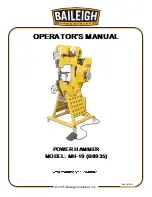
146
CHAPTER 6:
Maintenance and Troubleshooting
Model CRX-6.5K Probe Station
6.3.5.2 Poor or Non-Ohmic Electrical Contact
There are several important considerations for assuring good electrical contact
between the probe and sample:
Pressure:
appropriate contact pressure is required for both establishing and
maintaining good contact. Too little pressure may result in high contact resistance,
resistance that changes significantly with time or is overly sensitive to vibrations. Too
much pressure will obviously cause probe damage. One way to ensure repeatable
contact pressure is to monitor the distance the probe tip skates when being landed as
described in section 4.6.2. This distance is likely different for each different probe
material, tip radius and sample material. Another approach is to monitor the DC
resistance of each pair of probes while landing.
Tip radius:
a larger tip radius normally provides a larger area of contact, which
consequently lowers contact resistance. The larger tip can also tolerate slightly
higher pressure before being damaged. Smaller tips are normally chosen for probing
smaller features, but they can also be useful in scratching through electrically
insulating oxide layers that may form on the sample surface. For more information,
please reference section 2.6.3.
Tip material:
Lake Shore offers several tip materials for different applications. Not
every tip material is compatible with every sample material. For more information,
please reference section 2.3.2.1.
Dirty or damaged tips:
some tip materials, especially BeCu, form an insulating oxide
when exposed to air. Tips also get dirty during normal use. Bent or damaged tips
generally make very poor electrical contact. Clean and inspect probe tips for damage
regularly. For more information, please reference section 6.2.7.
Temperature change:
probe arms change length when their temperature changes,
necessitating lifting probe tips before changing temperature. The probe arms must
stabilize in temperature for approximately 10 to 15 min (in addition to the sample
stage) before probes can be landed effectively. If probes are landed too soon, the
position of the probe tip will shift, degrading the quality of electrical contact.
6.3.5.3 Loss of Continuity
Loss of continuity is nearly always caused by bad contact between the probe tip and
sample. If the contact resistance is known to be good and there is no continuity
between the signal connector and the probe, the cause is likely a broken center
conductor in the probe cable. This is often caused when the back of the SMA plug on
the cryogenic coaxial cable is not held steady when the ZN50 probe is installed. Check
the continuity of the center conductor by measuring the resistance between the
center pin of the signal connector and the center of the SMA connector. If the
resistance is not approximately zero, the cable must be replaced. Refer to section
5.3.5 for the procedure to replace the cable.











































